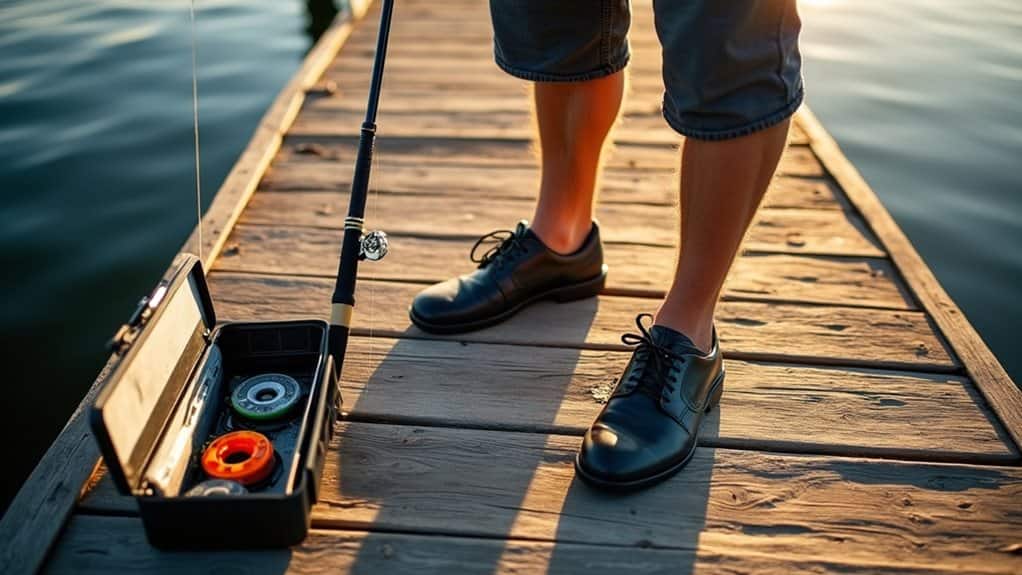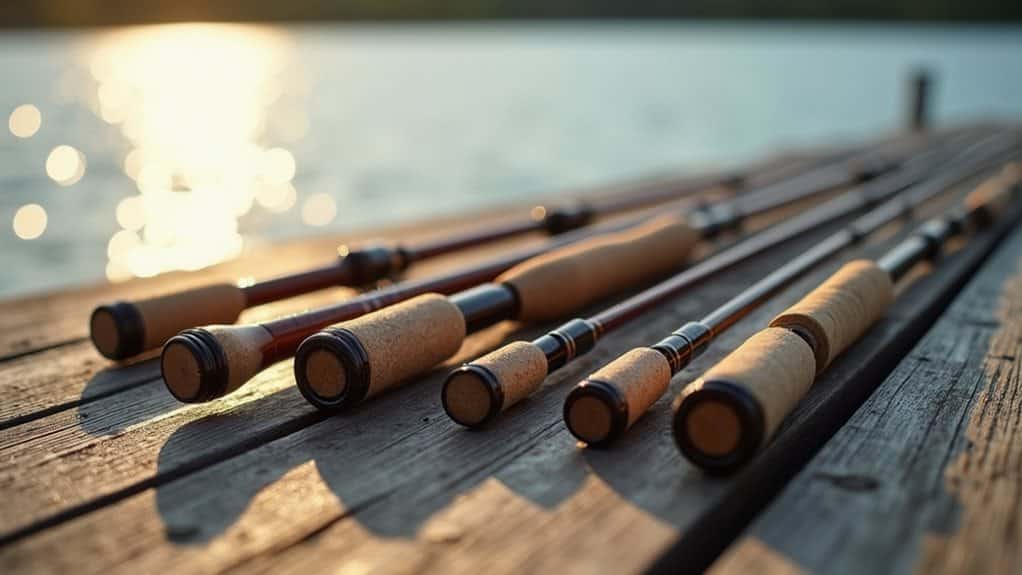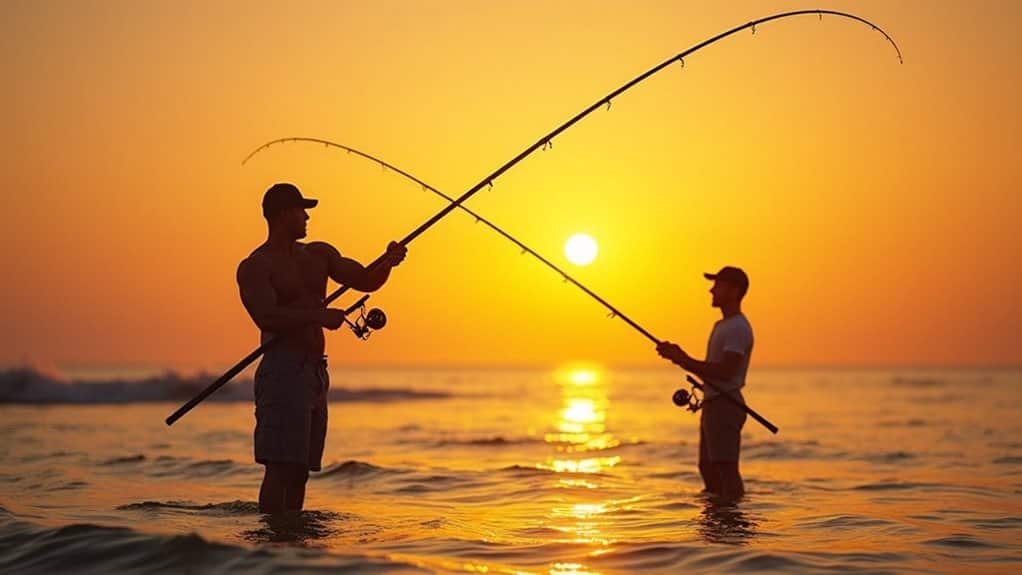You’ll want to choose your fishing rod length based on your target fish, fishing location, and personal comfort. For general fishing, a 7-foot medium-action rod offers excellent versatility. Shorter rods (5-7 feet) work best for small fish and tight spaces, while longer rods (8+ feet) excel at distance casting and larger game fish. Consider your height and strength when selecting – shorter anglers often prefer 6-7 foot rods, while taller anglers may opt for longer ones. Uncover how specific fishing techniques and environments can further refine your ideal rod choice.
TLDR
- A 7-foot rod provides versatility for most fishing situations and is a good starting point for beginners.
- Match rod length to target fish: 5-7 feet for small fish, 8-10 feet for large game fish.
- Consider your fishing location: shorter rods for rivers and brush, longer rods for surf fishing and open water.
- Your height affects rod choice: shorter anglers should use 6-7 foot rods, while taller anglers can handle longer rods.
- Choose shorter rods (under 7 feet) for tight spaces and accuracy, longer rods (over 9 feet) for distance casting.
Understanding Fishing Rod Length Basics

Selecting the right fishing rod length can make a significant difference in your angling success.
You’ll find that fishing rods come in three main categories: short rods under 7 feet, medium rods between 7-9 feet, and long rods over 9 feet. Each length serves specific purposes, with shorter rods excelling in tight spaces and accuracy, while longer ones provide better casting distance. Your personal height matters when choosing an appropriate rod length for maximum comfort and control. Additionally, using the correct line capacity for your chosen reel can enhance overall fishing performance.
Matching Rod Length to Your Target Fish
Your choice of fishing rod length should directly match your target fish’s size and the habitat where you’ll find them.
When you’re after small fish like trout in narrow streams, you’ll want a shorter 5-7 foot rod, while pursuing large game fish in open water calls for longer 8-10 foot rods with more backbone. For optimal portability and transport convenience, consider two-piece rods that can easily fit in your vehicle or rod locker. A good fishing tackle box can further enhance your fishing experience by keeping your gear organized and accessible.
Your fishing environment, whether it’s a cramped stream with overhanging branches or a wide-open beach, will also play a vital role in determining the ideal rod length for your needs.
Size Dictates Rod Length
The fundamental rule of matching rod length to fish size stems from the principle of control and advantage during the fight.
You’ll want a shorter rod for smaller fish species, as it provides better sensitivity and control for manipulating lightweight lures.
For larger fish, opt for longer rods that offer enhanced casting distance, better hook-setting power, and improved line control during the battle.
Species-Specific Rod Requirements
Whether you’re chasing trout in mountain streams or battling marlins offshore, matching your rod length to specific fish species can make the difference between success and frustration.
For pike and other predators, you’ll want 8-9 foot rods with heavy action, while perch fishing calls for lighter, shorter rods.
Trout anglers should opt for slightly longer rods, typically 6-8 feet, for better sensitivity and casting control.
Habitat Affects Rod Choice
Beyond selecting a rod based on fish species alone, understanding how fishing environments shape your rod choice can dramatically improve your success on the water.
You’ll need longer rods for deep water and high banks to maintain line control, while shorter rods work better in brushy areas with limited casting space.
Consider your fishing location’s physical obstacles and accessibility when choosing your rod length.
The Impact of Fishing Location on Rod Selection
Selecting an appropriate fishing rod length depends heavily on where you’ll be casting your line, as different fishing environments present unique challenges and opportunities.
For river fishing, you’ll want shorter rods of 5-7 feet to maneuver around obstacles, while surf fishing demands longer 10-15 foot rods for distance casting.
Lake fishing benefits from 7-10 foot rods, offering versatility for various techniques. Additionally, specific lakes like Lake Okeechobee provide unique fishing conditions that may influence your rod choice.
Essential Factors That Determine Rod Length Choice

Now that you understand how fishing locations affect rod length, let’s focus on the vital factors that’ll help you choose the perfect rod size for your needs.
Your height, physical strength, and comfort level play essential roles, along with your target fish species and preferred casting technique. You’ll also need to take into account your fishing environment’s obstacles and the technical specifications of different rod actions. Additionally, selecting the right circle hooks can enhance your overall fishing success, especially when targeting catfish.
Rod Length Performance in Different Fishing Styles
When you’re choosing between fishing from a boat or the shore, you’ll need to adjust your rod length accordingly, as boat fishing typically works better with shorter 6-7′ rods while shore fishing often requires longer 7-8′ rods for better casting distance.
Your specific fishing technique will also influence the ideal rod length, with finesse techniques demanding shorter, more precise rods and power fishing methods benefiting from longer rods that can handle heavier lures.
The environment you’re fishing in plays an essential role too, as you’ll want shorter rods for fishing under docks or trees, while open water fishing calls for longer rods that can cast further and manage more line effectively.
Boat Versus Shore Length
The distinct demands of boat and shore fishing greatly influence the ideal length of your fishing rod.
For boat fishing, you’ll want rods around 6-7 feet for easier maneuverability in tight spaces and convenient storage.
Shore fishing often calls for longer rods, typically 9-11 feet, as you’ll need greater casting distance and the ability to keep your line above obstacles.
Technique-Specific Rod Sizing
Different fishing techniques demand specific rod lengths to maximize your success on the water.
For jigging, you’ll want a medium-heavy rod between 6’6″ and 7’6″ with fast action.
When using crankbaits, opt for longer 7-8 foot rods, especially for submerged lures.
Finesse techniques work best with shorter, lighter rods, while flipping and pitching require compact rods for precise control in tight spaces.
Power and Action: Their Role in Rod Length Selection

Selecting appropriate rod power and action plays an essential role in determining the ideal length for your fishing rod.
You’ll need a longer rod if you’re using lighter power ratings, as this provides better control and casting distance for finesse techniques.
Conversely, when you’re working with heavy power ratings, you can often use shorter lengths while maintaining effective fish-fighting capability.
Practical Tips for Choosing Your Ideal Rod Length
When choosing your ideal fishing rod length, understanding how specific techniques and environments influence your selection can make all the difference in your fishing success.
Consider your height and fishing style—shorter anglers often do better with 6-7 foot rods, while taller anglers might prefer longer options.
For versatility, a 7-foot rod works well in most situations and techniques.
Final Note
Selecting the right fishing rod length doesn’t have to be complicated. You’ll want to take into account your target fish, fishing location, and preferred technique when making your choice. For most general fishing situations, a 6-7 foot rod will serve you well, but don’t hesitate to go longer for big game fish or shorter for tight spaces. Remember, you’ll fish best with a rod that matches your specific needs and feels comfortable in your hands.




